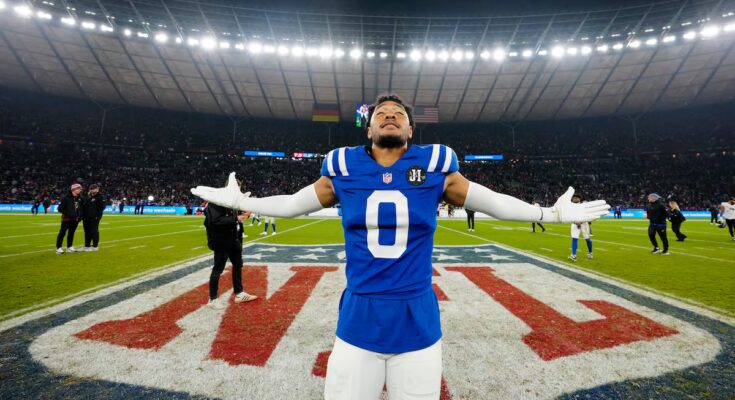The planet of American football lands in Spain as a new territory to be conquered in a process of expansion with more than two decades of celebrating NFL regular season games. With London as their epicentre, franchises tested new markets, both in America – mainly Canada, then Mexico and, finally, Brazil – and in Europe. After the satisfying experience in Germany, which began in Munich and arrived this Sunday in Berlin with the duel between the Indianapolis Colts and Atlanta Falcons, it is the turn of Madrid, chosen for its sporting culture, the solvency of a stadium like the Santiago Bernabéu and the window it offers to the Spanish-speaking public. For this reason the Miami Dolphins invested one of their home games on the other side of the ocean, a precious asset for a 17-game competition, excluding the playoffs. Sunday’s game against the Washington Commanders not only stands up to the sporting event of the year in the capital, but is the beginning of a relationship that the league, seeking fertile markets, intends for the long term.
While America’s major leagues in baseball, basketball and hockey have added more and more foreigners over the course of the 21st century, to the point of challenging the might of the United States, American football has no notable barns outside the country. Without ambassadors like Pau Gasol or Luka Dončić to conquer the markets, the NFL is betting on its expansion by taking its franchises all over the world. What began as anecdotal matches in Canada took on a global tone in the 1990s towards the United Kingdom, Japan or Germany, a menu that included Barcelona, which hosted the Los Angeles Raiders’ victory against the Denver Broncos on July 31, 1994 at the Estadi Olímpic. All friendlies, a very devalued concept in American football, given that stars rarely take risks in the preseason. The first game of the regular season was played in 2005 by the Arizona Cardinals and San Francisco 49ers at the Azteca Stadium in Mexico, but London became a regular, annual fixture that soon hosted four games, in 2017. Most of the 32 franchises played at Wembley.
The NFL’s next step was to bet on the tradition of Germany, the European country most involved in the NFL Europe project after symbolic friendlies like the one in 1990 at the Olympiastadion between the Los Angeles Rams and the Kansas City Chiefs in what was still West Germany. The return to Berlin, exactly 36 years after the night of the fall of the Wall, comes after four matches played between Munich and Frankfurt between 2022 and 2024. The league’s data speaks of 20 million followers in Germany, its main base in Europe, compared to the 11 million it assigns to Spain, a very large statistical umbrella. The 11 franchises with commercial rights in Germany organized activities this weekend. In addition to the Dolphins, in Spain the Chicago Bears and the Kansas City Chiefs of Patrick Mahomes, the great quarterback contemporary.
Real ends a calendar of seven matches abroad in 2025, which began in Sao Paulo, continued in Dublin and kept the main dose in London, with three dates. “These matches are authentic catalysts in their countries”, underlines the executive vice president of the NFL in charge of the international division, Peter O’Reilly, who guarantees “world-class entertainment”, as if it were a “mini Super Bowl”, with a musical show at halftime – Bizarrap and Daddy Yankee will do it in Madrid -, speaks of the Bernabéu as an “iconic” stadium and appreciates the collaboration with the City Council and the Community of Madrid. “Spain is a very important market for the NFL, not only for its rich sporting history, but also for its passionate fan base from which we want to continue to grow.” The opening of a permanent headquarters in the country and the appointment of a coach from the league in Spain, Rafa de los Santos, is “a commitment to this market that could go well beyond this first match”.
O’Reilly highlights the “incredible response” from local audiences, including Spaniards. “People often think of these games as people traveling from the United States, but the vast majority, about 90%, of viewers come from the market itself.” That is, of the country. When choosing destinations, the league prioritizes the size and commitment of local fans, something it calibrates through previous events such as those in Madrid or Berlin or media traffic and social networks. Added to this is the economic fabric – there are around twenty main sponsors for the Spanish debut – and the solvency of the stadium. “It’s a huge factor. When we were there during the renovation, we were impressed by how they manage to maintain their incredible history in such a modern way. Real Madrid has been a great partner, it’s a great global brand.”
At the halfway point of the season, the NFL boasts a television product with 35 games (26% of the total) decided by a score in the last two minutes, the best figure in its history. It also boasts its best eight-day audience since 2015, following annual growth of 7%. Rio de Janeiro and Melbourne will debut as venues next year, which will be the first official match in Australia. The league plans to expand on six-month schedules; If Spain follows the German example, it could happen again in 2027. “Every market is unique. Spain is very important in itself, but it also has that halo effect cross the borders of the Spanish-speaking world. We started with a base of 11 million and our aim is to go deeper,” explains O’Reilly, taking the London model as a reference. “We are seeing that the maturation process is even faster in Spain. This match will allow us to accelerate it.”



